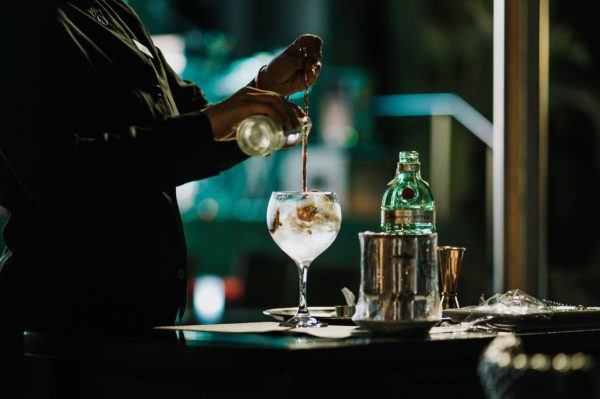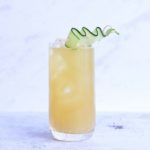If you’re a gin and tonic lover, you could probably wax poetic for hours on all the virtues of gin. It’s herbal, floral, and goes wonderfully in a variety of cocktails. But what do you really know about gin, other than how great it tastes? Where does it come from? How is it made? What are the different types?
Gin is an incredibly interesting, complex liquor with a fascinating history. Gin is adored by many, but very few people know much about it. We’ll you’re about to become one of the lucky few in the know about this delicious botanical spirit as we dive in deep and learn everything there is to know about gin.
What is gin?
Gin is a clear spirit made from a grain mash, usually barley or corn. Just like vodka, gin is column-distilled, which allows for the continuous stripping of alcohol from water. In fact, the processes for making gin and vodka are essentially identical until one essential step. Gin is distilled or redistilled with a unique blend of botanicals and other ingredients, which produces an intentionally flavorful spirit.
The spices and botanicals that go into gin vary from brand to brand. You’ll almost always be hit with juniper as the most prominent flavor, no matter the blend. Juniper tastes very pleasant and floral and has an assertive, woodsy, piney flavor.
Gin, in general, doesn’t have strict laws that state it can only be produced in a certain place, so it’s made all over the world. However, 13 specific types of gin must be made in designated geographical locations. Many gins are produced in the U.K., and the Netherlands has been a big gin producer throughout history.
History of gin
Gin has its roots in 16th century Holland when the Dutch began producing a genever liquor for medicinal purposes. Liquors have been used as medicine frequently throughout history, but usually, they were developed for drinking first, then used for medical applications, not the other way around.
Genever was specifically developed by the Dutch as medicine. Genever is a malt barley-wine-based spirit, and when it was first developed, it tasted pretty disgusting. Juniper was then added to the mix to help mask the harsh flavor. Genever is still around today, but an offshoot of the liquor, known as gin, dropped the barley wine components and kept the juniper.
Juniper has been combined with alcohol and used in medicinal applications far before the Dutch did it in the 16th century. In 70 A.D., a Greek physician named Pedanius Dioscorides published a five-volume encyclopedia all about herbal medicine. In this encyclopedia, Dioscorides provides a detailed description of his use of juniper berries steeped in wine to combat chest ailments. In 1055, Benedictine Monks of Solerno, Italy, penned a recipe for a tonic wine infused with juniper berries. So, it turns out that the Dutch’s idea wasn’t so original after all.
The beginnings of gin
The first known written use of gin was in a book from 1714 entitled “The Fable of the Bees, or Private Vices, Publick Benefits” by Bernard Mandeville. Mandeville wrote of the spirit: “The infamous liquor, the name of which derived from Juniper-Berries in Dutch, is now, by frequent use… shrunk into a Monosyllable, intoxicating Gin.” The name supposedly comes from “Gen,” a shortened version of the word “Genever.” Over time, “Gen” evolved into “Gin.”
In the late 1600s, William III of England, a Dutchman, became England, Scotland, and Ireland. He began his reign by enforcing blockades and introducing heavy taxes on French wine and Cognac to weaken France’s economy. Simultaneously, William III instituted The Corn Laws in England, which provided tax breaks on spirit production. These phenomena led to what is now known as the “Gin Craze” in England.
Gin was cheap and could be produced by anyone. However, since gin production was basically a free-for-all, people added things like turpentine, sulphuric acid, and sawdust to their liquors. Eventually, distiller’s licenses had to be introduced, so the government could gain some control over who was making gin and what was going into it.
So many people were gin obsessed and died from toxic gin; gin was vilified by the British during the 18th century. It got so extreme that Parliament introduced the Gin Act in 1751, which cracked down on the production and consumption of spirits. By the 1830s, beer became cheaper than gin again for the first time in over a century.
A new production method turned things around
After 1830, things began to look up for gin again. Aeneas Coffey invented a new kind of still that revolutionized liquor production around the world, and gin distillers quickly embraced it. The new still allowed producers to make a gin that was cleaner, purer, and tastier.
Another boost for gin’s reputation came from the British Royal Navy, in a fairly roundabout way. Sailors often had to travel to where malaria was prevalent, so they brought quinine medicine to prevent and fight the disease. Quinine tasted terrible, so a brand called Schweppes invented tonic water to help make the medicine go down. Since London Dry Gin also often accompanied sailors on their voyages, eventually, the gin was combined with the tonic and viola. The classic cocktail was born.
The history of gin has remained fairly stagnant since the early 20th century. It no longer has a reputation for being deadly. In fact, gin has been embraced as a craft cocktail ingredient and is the basis for many classic beverages.
How is gin made?
The basic process for making gin starts with extracting pure alcohol or ethanol from a base spirit. Then, the ethanol is redistilled with juniper berries and other botanicals. The botanicals impart flavor into the alcohol, which is what gives gin its herbal, floral notes. There are three main techniques that distillers use to infuse botanicals into ethanol.
1. Steeping
When using the steeping technique, the distiller mixes the ethanol and the botanicals together in a large metal container over a heat source known as a pot still. The botanicals then steep into the base spirit, much like tea. Depending on how strong the distiller wants the flavor of the gin to be, they may remove the botanicals after a short period of time or leave them to steep for up to 48 hours.
2. Vapor infusion
This method utilizes a modified still called a Carter-head. The Carter-head still has a basket that is suspended over the still. The basket is filled with botanicals and is suspended over the still, filled with the base spirit. As the spirit is heated, the ethanol vapors rise up and into the basket, allowing the botanicals to release their essential oils into the vapors. The vapors then reliquify, now containing the essence of the botanicals.
3. Vacuum distillation
This is also known as cold distillation. This technique utilizes a low-pressure vacuum environment, which greatly reduces the boiling point of the ethanol. According to distillers, avoiding extreme heat allows the flavors from the botanicals to remain more intact.
Some distillers combine steeping and vapor infusion methods and blend the products together to make a compound gin.
What are the different types of gin?
There are a huge variety of different types of gin made all over the world. Some are more herbal and bitter, while others are much more mellow. Each type offers unique flavors and aromas.
London Dry Gin
London Dry gin originates in, you guessed it, London. However, not all London Dry gin has to be made in England. London Dry is a style that is now produced all over the world. This is what most people think of when they think gin. Juniper is usually the most prominent botanical flavor, with notes of citrus, angelica root, and coriander on the finish. Some London Dry gins steep in fresh or dried citrus peel before distillation, imbuing them with bright, citrusy flavors.
Most London Dry distillers bottle their gins at a very high proof, which makes the spirit versatile and great for use in various cocktails. The term “dry” in the title doesn’t mean the gin isn’t sweet, as it does in the context of wine. It simply means that there is no artificial flavoring added and that all the flavors are naturally produced by the botanicals.
Plymouth Gin
Plymouth gin is like London Dry gin’s more mellow cousin. Plymouth gin is only made by one distillery in the South of England. Plymouth Gin Distillery is one of the oldest recorded distilleries in the U.K, and they’re the only ones with the right to make Plymouth gin.
When it comes to flavor, Plymouth gin is drier than London Dry and more citrus-forward than juniper-forward. You may notice a spicier finish from their special blend of seven botanicals, including juniper, coriander seed, dried sweet orange peels, cardamom, Angelica root, and Orris root. It should be noted that Plymouth Distillery also produces a Navy Strength Gin, which is 57% ABV, and much closer in character and flavor to London Dry.
Old Tom Gin
Old Tom is an older gin style with a rich, malty mouthfeel and a distinct citrusy sweetness. Old Tom gin was very popular in 17th century London during the gin craze. It became known as bathtub gin because people would literally make it in their bathtubs. People added things like licorice, or other sweetening agents, to intentionally make the gin sweeter and cover up any foul flavors.
Old Tom gin isn’t made in bathtubs anymore. It’s an elegant style of gin with a delicate sweetness that usually comes from licorice in the distillation process. Old Tom is richer in flavor than London Dry gin and works really well in various classic cocktails, such as the Tom Collins.
Genever
Genever is sometimes called the grandfather of gin. Gin evolved from genever, which originated in 16th century Holland. Genever has a more robust flavor than gin because genever’s base grains are malted, similar to whiskey. Genever is flavored with juniper and other botanicals, but to a lesser extent than gin.
Flavor-wise, you’ll notice that genever differs from gin quite a bit. While the main flavor you notice in a gin is usually juniper, genever’s dominant flavor is malt, which is usually complemented by cloves, caraway, ginger, and nutmeg notes. Genever is incredibly rich in flavor and makes an excellent choice for cocktails like a Gin Old Fashioned or anything with sweet vermouth.
International Gins
Since there aren’t any strict laws about where gin can be produced, distillers worldwide produce different styles that don’t fit into any of the above categories.
New varieties of gin pop up seemingly every day from countries like Spain, Japan, Brazil, and the United States. Since there aren’t any rules about what can be put into gin, international distillers often use local roots and botanicals.
Our favorite gins
There are so many amazing gins to try out there; it can be hard to choose where to start. We’ve compiled a list of some of our favorite gins. Some are classic and standard, while others are new and exciting. You won’t want to wait to try them all.
Tanqueray Gin
Tanqueray’s most popular gins out there is a London Dry gin with distinct flavors of juniper, coriander, angelica, and licorice. It’s an incredibly balanced gin with distinct herbal quality and a dry finish.
Tanqueray is an incredibly award-winning gin and awarded Bartenders’ Choice of Gin at the 2020 Drinks International awards for eight years running. It makes a perfect gin and tonic, or it can be used as a base for various other lovely gin cocktails.
Bombay Sapphire Gin
You’ll probably recognize this gin’s iconic blue bottle, even if you’ve never tried it. Bombay Sapphire is a London Dry gin made from a unique combination of ten hand-selected exotic botanicals from all around the world.
This gin is world-renowned for its extraordinary smoothness and balanced taste. It’s incredibly aromatic with a crisp yet delicate finish. It’s a great addition to any at-home bar because it’s incredibly versatile and makes the perfect base for various classic and contemporary cocktails.
Hendrick’s Gin
Hendrick’s Gin proudly bills itself as “a most unusual gin.” It definitely is unusual, in the best possible way. Hendrick’s is a small-batch gin made in Scotland. IIt is infused with cucumber and rose with the traditional juniper, and those flavors definitely come through when sipped.
Hendrick’s is a compound gin, meaning it is a blend of gins made using two different stills: the Bennet still and the Carter-Head still. The result is an exceptionally smooth gin with a beautiful balance of subtle flavors.
The Botanist Islay Dry Gin
The Botanist Islay Dry Gin, the first and only in a new style of gin hailing from Scotland, is an incredibly versatile dry gin made from a blend of 22 different botanicals hand-foraged locally sustainably on the Scottish island of Islay. The botanicals are harvested at varying times of the year, then lovingly infused into the gin during the slow, simmer distillation process.
This gin is beautifully complex yet versatile, so it makes a great base for various cocktails. This is one of the smoothest gins out there and makes an absolutely killer martini.
Beefeater Gin
Beefeater Gin is a classic London Dry gin whose recipe dates all the way back to 1863. It offers lovely spiced, fruity notes and is distilled with botanicals such as angelica root and seeds, juniper, coriander seeds, almonds, licorice, Seville oranges, lemon peel, and orris root. The gin is steeped in these botanicals for a full 24 hours, so the distillation can fully extract the flavors. The result is a beautifully dry gin with a gorgeous herbal bouquet and a citrus back.
Beefeater is synonymous with London itself and is named after the Tower of London ceremonial guards. In fact, the Beefeater distillery is one of only nine distilleries still operating in London itself. Beefeater is smooth enough to sip straight and is great in a variety of cocktails.
Nolet’s Silver Dry Gin
Nolet’s Silver Dry Gin has been crafted in Holland for over 325 years and passed down through 11 generations of the Nolet family.
Nolet’s is a fresh and surprising twist on a classic gin, featuring unusual flavors such as fragrant rose, juicy, succulent peach, and slightly tart raspberry. It’s a floral and fruit-forward gin with a fruit-driven palate and a classic, dry finish. Nolet’s is smooth and balanced and goes great in a variety of fruity cocktails.
Boodle’s Gin
Boodle’s is an expertly crafted London Dry gin. It was originally only available to members of London’s exclusive Boodle’s Gentlemen’s club. Today, this incredibly versatile gin is available to everyone. It’s an incredibly clean gin, distilled from British wheat, then redistilled with incredible botanicals.
Boodle’s doesn’t use citrus but traditional herbs and spices such as nutmeg, sage, and rosemary. The result is a gin with a mellow yet herbal palate, which perfectly balances the piney notes from the juniper. Boodle’s offers an incredible warming quality, making it perfect in a gimlet or 50/50 Martini.
No. 3 Gin
If you’re looking for the quintessential London Dry gin, look no further than No. 3. This gin stays true to the classic hallmarks of a London Dry and sticks to the hallmark botanicals that define the style: juniper, citrus, and spice.
No. 3 is a relatively new gin, launched in 2010, but it is already incredibly awarded and well-respected among distillers. No. 3 is a classic, versatile gin that makes a great addition to any bar cart.
Plymouth Gin
Plymouth Gin is incredibly unique, as it is a style all its own that can only be produced at one distillery in Plymouth, South West England. Black Friars Distillery is the oldest working distillery in England. It has been making the stuff since 1793, utilizing a unique blend of seven botanicals, soft Dartmoor water, and pure grain alcohol.
On the nose, Plymouth gin offers a rich, fresh aroma of juniper, followed by notes of coriander and cardamom. The palate is extremely smooth, creamy, and full-bodied, with a slight sweetness. The finish is elegant, long, fresh, and aromatic. If you’ve never tried this gin, it’s definitely one to add to your list.
Ransom Old Tom Gin
Ransom Old Tom Gin is a historically accurate revival of the most popular style of gin from the 1800s. Old Tom gin uses a malted barley base, which gets combined with an infusion of botanicals in high-proof corn spirits. The final distillation is run through a unique alembic pot to preserve the maximum amount of aromatics, flavor, and body.
Ransom Old Tom tastes like history and makes a perfect base for a variety of pre-Prohibition era cocktails.
Diep9 Old Genever
Diep9 Old Genever hails from Flanders, Belgium, the birthplace of the genever style. This genever begins with rye, wheat, and malted barley and is distilled with nine botanicals in a copper pot, the traditional distillation method. It is then aged in French Oak and sweetened. The result is a smooth, malty genever with a very slight sweetness.
The palate offers slight fruitiness, with citrus and leafy greens and malty, peppery, leathery notes. Fans of malty, grainy spirits will absolutely adore this genever.
The best gin cocktail recipes
While gin can be sipped straight or on the rocks, it is best enjoyed mixed into a cocktail. We’ve compiled some of our favorite gin-based cocktail recipes. Some are classic, some are contemporary, but all are delicious.
Classic Gin and Tonic
The gin and tonic is a cocktail that every aspiring bartender must master. It’s simple but classic, light, and refreshing. It makes an excellent choice for a happy hour, dinner, or really any time you want to enjoy a light beverage. Since G&Ts are so simple, you want to select a really good gin and a really good tonic. Any style of gin you love works.
To make a classic gin and tonic, you’ll need:
- 2 oz. gin of choice
- 4-6 oz. of tonic water
- Lime wedge, for garnish
In a highball glass filled with ice, pour your gin, then top with your tonic. Gently stir to combine, but not too much, as you’ll lose carbonation. Garnish with your lime wedge, serve, and enjoy.
Dry Martini
Another incredibly classic cocktail, the dry martini, has several iterations and can be made with various different liquors. Many are proponents of the vodka martini, but gin offers a much wider array of herbal flavors, which are perfectly showcased by the martini’s simple ingredients. Like the gin and tonic, you want to select a really high-quality gin since this cocktail is so simple.
For this recipe, you’ll need:
- 2.5 oz. gin
- 1.5 oz. dry vermouth
- 1 dash orange bitters
- Lemon peel for garnish
Add your gin, dry vermouth, and orange bitters into a mixing glass with ice, and stir until cold. You don’t want to water down your drink; you just want it perfectly chilled. Strain into a chilled martini glass, and garnish with a twist of lemon.
Tom Collins
If you’re a fan of lemonade, you’ll absolutely love the Tom Collins. It’s simple and incredibly refreshing. It’s lightly sweetened, and the simple ingredients allow the botanicals in the gin to really shine. The Tom Collins can be made with any gin you like, but we recommend trying it with Old Tom gin for a richer, maltier flavor.
For this recipe, you’ll need:
- 2 oz. gin
- 1 oz. freshly squeezed lemon juice
- ½ oz. simple syrup
- Club soda
- Lemon wheel to garnish
Add your gin, lemon juice, and simple syrup to a Collins glass. Fill with ice, then top with club soda and stir gently. Garnish with a lemon wheel and enjoy.
Singapore Sling
The Singapore Sling is a classic gin cocktail that’s been around for over a century. It was invented in 1915 by Ngiam Tong Boon at the Long Bar in Singapore’s Raffles Hotel. It’s sweet, sparkling, and incredibly delicious. There are newer variations to the recipe, including things like pineapple juice, grenadine, and orange liqueur, but we prefer the gentle sweetness of the classic.
For this recipe, you’ll need:
- 1.5 oz. gin
- 1 oz. Bénédictine liqueur
- ½ ounce cherry liqueur
- 1 oz. lime juice
- ¼ oz. simple syrup
- 2 oz. club soda
- Lemon slice and maraschino cherry for garnish
In a cocktail shaker filled with ice, combine your gin, Bénédictine, cherry liqueur, lime juice, and simple syrup. Shake until well-chilled. Strain into a highball glass filled with fresh ice, then top with club soda. Garnish with your lemon and cherry, and enjoy.
Bee’s Knees
The Bee’s Knees is a Prohibition-era cocktail that is gently sweetened with honey, hence the name. It’s a take on the classic Gin Sour, made with gin, lemon, and sugar. Replacing the sugar with honey creates a richer, more complex cocktail that perfectly complements the herbal flavors in the gin. The Bee’s Knees is a simple cocktail, but it’s a real treat. It’s refreshing, lightly sweet, and perfectly balanced.
To make this recipe, you’ll need:
- 2 oz. gin
- ¾ freshly squeezed lemon juice
- ½ oz honey syrup (equal parts honey and water, cooked in a saucepan over medium heat)
- Lemon peel for garnish
Add your gin, lemon juice, and (cooled) honey syrup to a cocktail shaker with ice. Shake until well chilled. Strain into a cocktail glass, and garnish with a lemon twist.
Frenchie
The Frenchie was invented by Los Angeles bartender Somer Perez. It’s incredibly refreshing and utilizes St-Germain elderflower liqueur. St-Germain is incredibly herbal and is a natural complement to gin’s botanical flavors. Different gins will have slightly different effects when it comes to flavor in this cocktail. Milder gins will take a backseat to the St-Germain and the grapefruit juice, whereas bold gins like London Dry will be much more flavorful and prominent.
To make this recipe, you’ll need:
- 2 oz. gin
- ½ oz. St-Germain elderflower liqueur
- 2 ½ oz. freshly squeezed grapefruit juice
- Grapefruit wedge to garnish
Add all your ingredients to a cocktail shaker, and fill with ice. Shake until well-chilled, then strain into a highball glass filled with fresh ice. Garnish with your grapefruit wedge, and enjoy.
The takeaway
Gin is a long-standing liquor with a fascinating history. From its beginnings as medicine to its reputation for making people go mad in the 1600s in London’s current position as a craft cocktail ingredient, gin has had quite the wild ride. There are so many amazing types of gin made all around the world. Some are classic; some are more modern. One thing is for sure: gin is a bartending staple that makes some really amazing cocktails.
For all your liquor delivery needs, you can count on Saucey. We offer speedy delivery and absolutely no order minimums on many wines, beers, and spirits. Browse our incredible selection of gins and treat yourself to something new today.




